"Ia! Ia! Cthulhu Fhtagn!"
 Posted : 16 years, 9 months ago on 8 October 2008 02:11
(A review of The Call of Cthulhu)
Posted : 16 years, 9 months ago on 8 October 2008 02:11
(A review of The Call of Cthulhu)Adapted from one of H.P. Lovecraft's most famous and celebrated short stories, The Call of Cthulhu is a story I thought could never really be filmed properly. When I first heard it was being made, I just knew they were going to ruin one of my favorite Lovecraft stories. However, there was some hope for it since it was being produced by the H.P. Lovecraft Historical Society (a collective of dedicated Lovecraft fans). I was impressed with the promo trailer; and when I finally saw the finished product, it actually exceeded my expectations. This is by far the most faithful Lovecraft adaptation I've ever seen. What makes the film work for me is the concept behind it. Lovecraft wrote The Call of Cthulhu in 1926; and what the filmmakers did was shoot it as a silent black & white film with title cards, as though it was made in 1926. It was the only way to make the film with the small budget they had, and it comes off beautifully. The make-up, the lighting, the props, the period clothing, the stop-motion Cthulhu FX, the silent-era style of acting, and the symphonic music score all add to the authenticity and atmosphere of the film. Plus they developed a post-production process called "Mythoscope", which added film grain and other aging artifacts you would find in a silent-era film. The set construction for the sunken city of R'lyeh was impressive (especially considering that the bulk of it was cardboard). It's a mix of surrealism combined with the expressionistic set design of certain silent horror classics. The swamp scene was also memorable. The fog rolling through the trees as the inspector and his agents trek through the swamp with lanterns to discover the Cthulhu cultists in the middle of an infernal ritual. I've mentioned the pros of the film, now for some cons. The low budget necessitated shooting it on digital video, and you can tell its video, but the "Mythoscope" process I mentioned earlier helps give it somewhat of a film-look. This is a minor thing, and it doesn't detract from my enjoyment of the movie. Some may feel a bit under-whelmed when Cthulhu appears. Anyone who's read The Call of Cthulhu already has their own idea of what Cthulhu looks like in their imagination. I understand what the filmmakers were going for here - a stop-motion creature that would be authentic to a '20s-era silent film; and I think they succeeded in doing that (even though I imagined Cthulhu being a bit more gargantuan and rotund than he appears here). This film should certainly appeal to fans of Lovecraft's fiction, who've been yearning for an accurate film adaptation of his stories, as well as to fans of silent horror cinema. If you're not that keen on Lovecraft and not that fond of silent films, then this movie will probably bore you to death. Now I can't wait to see the HPLHS' next project, THE WHISPERER IN DARKNESS, currently in production. It's going to be set in the same time period the story was written; and since that was 1931, this film will be a "talkie".
 0 comments, Reply to this entry
0 comments, Reply to this entry
Dead Next Door Review
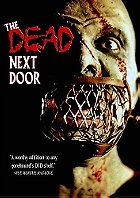 Posted : 16 years, 9 months ago on 7 October 2008 03:29
(A review of The Dead Next Door (1989))
Posted : 16 years, 9 months ago on 7 October 2008 03:29
(A review of The Dead Next Door (1989))A fairly ambitious, ultra-violent and ultra-low budget homage to George Romero's zombie films. It was shot on Super 8mm by J.R. Bookwalter in Akron, Ohio around 1986; and partially funded by an uncredited Sam Raimi. It has the distinction of being the most expensive Super 8mm film ever produced, clocking in at around $125,000. The movie follows a "Zombie Squad" in search of a serum that will reverse the zombification process. Along the way, they run into a religious cult led by an insane reverend who's trying to control a commune of the living dead. One member of the "Zombie Squad, Dr. Moulsson, seems to be modeled after the "Dr. Frankenstein" character in George Romero's DAY OF THE DEAD. The names of most of the characters in the film are blatantly obvious to horror fans: Mr. Raimi, Dr. Savini, Commander Carpenter, King, Romero, Reverend Jones (you get the picture). The low budget shows, but the film still manages to achieve some great splatter moments; zombie gutmunching; head explosions; gunshot squibs (all the proper ingredients for a zombie film). There are also some inspired and memorable scenes in the film; zombies trying to get to the White House lawn; zombies popping up in front of the Washington Monument; the opening credits with zombies pulling people out of their cars and causing general mayhem; zombies attacking a "save the zombies" protest group; and a zombie-on-a-leash acting as a "bloodhound". Bruce Campbell also has an uncredited, off-camera, role in the film. He did the voice-over dubbing for the Mr. Raimi character played by Pete Ferry. In short, this is a must for all diehard zombie fans. How do you know if you'll like DEAD NEXT DOOR? Well, if you find Andrea Bianchi's BURIAL GROUND and Bruno Mattei's HELL OF THE LIVING DEAD a rewarding cinematic experience, then you should certainly enjoy this film. If on the other hand you think the DAWN OF THE DEAD remake and the RESIDENT EVIL films are the ultimate in zombie cinema, you'll probably find this movie cheap, boring, and uninspired.
 0 comments, Reply to this entry
0 comments, Reply to this entry
Essential for Classic Literary Horror Fans
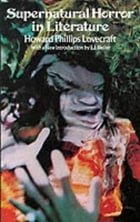 Posted : 16 years, 9 months ago on 3 October 2008 10:31
(A review of Supernatural Horror in Literature)
Posted : 16 years, 9 months ago on 3 October 2008 10:31
(A review of Supernatural Horror in Literature)This is quite simply one of the best essays ever written on the history of horror literature. It was written by Lovecraft over a three year period from 1924-1927, on the request of fellow writer W. Paul Cook; and first published in a folio-sized magazine called "The Recluse" in 1927. Lovecraft continued to make revisions to the essay throughout the '30s, until his death in 1937. It was published with these revisions, posthumously, in 1939 by August Derleth and Donald Wandrei's Arkham House and included in "The Outsider And Others". It was published again in 1945 by Ben Abramson with a Foreword by August Derleth. This current edition that I'm reviewing was originally published by Dover in 1973, and replaces the foreword by Derleth with an Introduction by E. F. Bleiler. In this 128 page essay, Lovecraft not only exposes his influences, but shows a fine critical sense as well. This work provides a virtual checklist of classic literature for horror fans to seek out. Some of the authors covered are well known like Bram Stoker, Joseph Sheridan LeFanu, Nathaniel Hawthorne, Samuel Taylor Coleridge, Charles Dickens, Mary Shelley, Henry James, and Edgar Allan Poe (who has a whole chapter devoted to him). Others are lesser known today (at least in the mainstream market), but just as important to horror literature; like Charles Robert Maturin, Lord Dunsany, Arthur Machen, and Algernon Blackwood. "Supernatural Horror In Literature" is broken into 10 chapters, arranged chronologically, beginning with the earliest tales of supernatural occurences and continuing up through modern writers that Lovecraft admired. The chapters are as follows: 1-Introduction; 2-The Dawn of the Horror Tale; 3-The Early Gothic Novel; 4-The Apex of Gothic Romance; 5-The Aftermath of Gothic Fiction; 6-Spectral Literature on the Continent; 7-Edgar Allan Poe; 8-The Weird Tradition in America; 9-The Weird Tradition in the British Isles; 10-The Modern Masters. For Lovecraft fans this is absolute must, to see the threads of influences that Lovecraft used to sew his own unique vision of cosmic horror. Even for those who are not particularly fans of Lovecraft's style of horror, this is still a fascinating read that traces the supernatural element from man's first written works all the way up to the 1930's.
 0 comments, Reply to this entry
0 comments, Reply to this entry
LUCKER Review
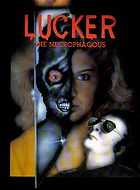 Posted : 16 years, 9 months ago on 2 October 2008 05:06
(A review of Lucker (1986))
Posted : 16 years, 9 months ago on 2 October 2008 05:06
(A review of Lucker (1986))Let me start this review off by saying this is a movie most people have never heard of, even many horror fans. Those who have heard of it know it's reputation as "sicko-sinema" sleaze; and for those few who've actually seen it - you either love it or hate it. If Synapse Films hadn't released the DVD, it would have just languished in the obscurity of underground horror bootleggers (where it originally built its infamous reputation and gained its cult status). LUCKER is an ultra-low budget film shot for about $30,000 in Belgium back in 1985 by Johan Vandewoestijne. He was a film student at the time, and the movie definitely reflects that - with all the flaws that come with a first-time film. Nick Van Suyt's performance as John Lucker is effectively creepy and noteworthy. Suyt apparently committed suicide. The story begins with serial rapist, murderer, and necrophile John Lucker recovering in a clinic, after a suicide attempt. He's been locked up in an institute for the past 3 years, following the murder of 8 women. He escapes after the gory killing of a male orderly (screwdriver in the eyeball). Lucker kills a nurse inside her car in the clinic parking lot and makes his escape with her car (and her body). After desecrating her, he abandons the car and the body and walks into the city, where he begins searching for Cathy Jordan - one of his would-be victims who managed to escape his murderous rampage 3 years prior. Mayhem, gory murders and necrophilia ensues. That's pretty much all there is to the plot. And when I say necrophilia, I don't mean freshly dead. Lucker prefers a decomposed, putrefying corpse (in the movie's most infamous scene). This, of course, draws comparison with Jorg Buttgereit's NEKROMANTIK films and Nacho Cerda's AFTERMATH; but LUCKER (which preceded them) drops the art-house style employed in those movies in favor of a gritty vision inside the mind of a disturbed psychopath, in which necrophilia is just one of his sordid pasttimes (but it's certainly the one you'll remember most when the film ends). It's a shame though, if the story had been fleshed out more and the filmmakers had some more money to work with, LUCKER could have been a powerful character study like HENRY: PORTAIT OF A SERIAL KILLER. But I still find it enjoyable for what it is. As for the production aspect, it was shot on 16mm. The "look" of the movie brings to mind filmmakers like Jim Van Bebber. I really like the soundtrack. It's synth-driven like many '80s horror films, and adds to the ambience. The incidental music is also enjoyable like the synth-pop song playing in the bar scene and the electro-industrial track "Vengeance" by the Belgian duo A Split Second. The lighting is also of note, with many of the key scenes lit in bright primary colors - reds, blues, and greens; which again brings to mind Jim Van Bebber and his lighting scheme for DEADBEAT AT DAWN. Of course, this lighting style has been used since the early days of color horror films by directors like Mario Bava, Terence Fisher, and Roger Corman when they wanted to give a scene a surreal dreamlike quality; and it works to that effect here (somewhat). LUCKER is not a dialog-driven film, and it's these scenes without dialog that work best. The English dubbing (or overdubbing) cheapens the film some and adds a bit of unintentional humor (also part of the film's cult appeal), but if you're used to low budget '80s horror it shouldn't really be a problem anyway. LUCKER originally had spotty distribution on VHS in 1986. However, the film found its target audience (avid gorehounds) when it was bootlegged by underground horror distributors in the late '80s and early '90s. I originally discovered it through the video maniacs at the now-defunct Ultra-Violent Video, which later became Blackest Heart Media (for those who remember the-good-old-days of horror collecting and tape trading, when finding these types of films was more difficult, mysterious and taboo). Now, thanks to Synapse Films, you can walk into your local media store and pick up LUCKER. Speaking of the DVD, I was pleasntly surprised to find the addition of more gore in some of the scenes, which was not on the old VHS bootleg. The original VHS version is also included as a bonus feature. The only other bonus is an informative featurette entitled Lucker: The Story Beyond the Film. So, if you enjoy (or like having your senses battered by) films such as Jim Van Bebber's ROADKILL: THE LAST DAYS OF JOHN MARTIN, William Lustig's MANIAC, HENRY: PORTRAIT OF A SERIAL KILLER, and the above-mentioned NEKROMANTIK, then you may want to add LUCKER to your collection. It's not quite in the same league as those films, but it's similar in tone, and should appease those who have a rabid craving for cheap and tasteless cinema extremes; and if you're a gorehound who can appreciate ultra-low budget filmmaking on the cheap with no redeeming social value whatsoever.
 0 comments, Reply to this entry
0 comments, Reply to this entry
Man Bites Dog Review
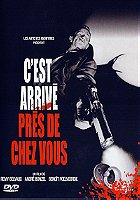 Posted : 17 years ago on 24 June 2008 12:58
(A review of Man Bites Dog)
Posted : 17 years ago on 24 June 2008 12:58
(A review of Man Bites Dog)MAN BITES DOG is a cinema verite-style mockumentary satire of the highest calibre. Sudden bursts of disturbing violence and sadistic brutality mesh with bleakly humorous moments of dark satire - all shot in stark black and white photography. Made by Belgian filmmakers Remy Belvaux, Andre Bonzel, and Benoit Poelvoorde and released amid a storm of controversy as well as critical acclaim, MAN BITES DOG would go on to win the International Critics Prize at Cannes in 1992. It's basically about a documentary crew making a film about the day-to-day life of a serial killer named Ben (played by Benoit Poelvoorde). Beneath the surface, it's a satire on media violence and the struggles of making a film with no money. But unlike Oliver Stone's satire on media violence, NATURAL BORN KILLERS, where the message was always "in your face", MAN BITES DOG's satire is subtle and just below the surface. I think it works better this way. Because the film is seen solely through the eye of the documentary camera, this makes the viewer feel like they're a part of the camera crew; and in the scenes of violence, brutality and murder it puts the viewer into the role of co-conspirator along with the rest of the documentary crew. Michael Haneke's 1997 film FUNNY GAMES plays with the viewer in a similar way, except in that film you feel more like a voyeur rather than conspirator. There's a point in MAN BITES DOG where the serial killer Ben becomes more than just the subject of the documentary. In essence he becomes the producer as well when the documentary crew accepts money from him in order to finish the film. By this time the crew have ceased to be subjectively documenting Ben's actions and are now willing participants in his madness (as is the viewer). This brings to my mind the Italian mondo documentary films like AFRICA ADDIO, where the filmmakers were accused of staging certain atrocities for the benefit of the camera, rather than documenting natural events; which also brings to mind CANNIBAL HOLOCAUST with its cinema-verite film-within-a-film mocking the same Italian mondos. The ending of MAN BITES DOG is also remarkably similar to the way CANNIBAL HOLOCAUST ends. I also noticed a reference to A CLOCKWORK ORANGE during the disturbing home invasion/rape scene. Even with all these references, whether intentional or not, this is still an extremely original film which should be seen by all adventuresome viewers.
 0 comments, Reply to this entry
0 comments, Reply to this entry
Mediocre Thriller
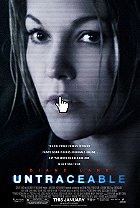 Posted : 17 years ago on 24 June 2008 12:55
(A review of Untraceable)
Posted : 17 years ago on 24 June 2008 12:55
(A review of Untraceable)This movie didn't really do much for me. It's a police procedurial suspense/thriller which tries to appeal to the SAW/HOSTEL crowd with a few somewhat gruesome torture/death scenes. Someone is abducting people and broadcasting there torture and death live over the internet by use of a webcam. The cast are capable, but there's no real stand-out performances. I guess it may be somewhat of a diversion for suspense/thriller fans, but I found it too tedious and derivative of the films it borrows from. Here's the ingredients for the film:
1 part SILENCE OF THE LAMBS
1 part SEVEN
1 part SAW
1 part HOSTEL
By the way, the whole premise for this movie was done before by Dario Argento in his 2004 giallo THE CARD PLAYER. I'm probably biased towars Argento, but I enjoyed his film much more
1 part SILENCE OF THE LAMBS
1 part SEVEN
1 part SAW
1 part HOSTEL
By the way, the whole premise for this movie was done before by Dario Argento in his 2004 giallo THE CARD PLAYER. I'm probably biased towars Argento, but I enjoyed his film much more
 0 comments, Reply to this entry
0 comments, Reply to this entry
"...In There Stepped A Stately Raven..."
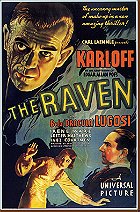 Posted : 17 years ago on 17 June 2008 11:11
(A review of The Raven)
Posted : 17 years ago on 17 June 2008 11:11
(A review of The Raven)Another fantastic Universal classic horror film starring Bela Lugosi and Boris Karloff, and based on the works of Edgar Allan Poe. Actually the title card reads "suggested by Edgar Allan Poe's immortal classic". It would be nearly impossible to make a feature-length film based solely on a poem of 108 lines. So what the filmmakers do is weave elements of Poe's poem into the story. For example, Bela Lugosi's death-obsessed character, Dr. Richard Vollin, is an admirer and collector of Poe's works. In addition to his Poe collection, Dr. Vollin has an extensive collection of torture devices in his hidden "dungeon", including the device from Poe's "The Pit and the Pendulum" (which does get put to use in the movie). The scene which introduces Lugosi is cinematic gold: The huge shadow of a raven fills the screen as Lugosi's distinctive voice intones, "Suddenly there came a tapping/As of someone gently rapping, rapping at my chamber door...", and the camera slowly pulls out to reveal Lugosi seated in an antique high-back chair with the raven silouette looming on the wall above him, as he continues to recite the poem, "...open here I flung the shutter, when, with many a flirt and flutter/In there stepped a stately raven." Beautiful scene. The story begins with Jean Thatcher (Irene Ware) crashing her car and suffering nerve damage to her brain. Her father Judge Thatcher (Samuel S. Hinds) and her fiance Dr. Jerry Halden (Lester Matthews) plead with imminent surgeon Dr. Richard Vollin (Lugosi) to save her life. Dr Vollin agrees and afterwards begins to fall in love with Jean. She also becomes somewhat infatuated with him. Her father Judge Thatcher sees this and all but threatens Dr. Vollin to put an end to his advances. This unrequited love aspect of the story resembles Poe's literary "lost love", Lenore. Boris Karloff's character, Edmond Bateman, is introduced about 16 minutes into the film. He's an escaped convict and murderer who comes to Dr. Vollin to alter his face, so he won't be recognized and so he won't be "ugly" anymore. However, true to his sinister and sadistic character, Dr. Vollin actually disfigures Bateman's face; and tells him he'll fix it only after Bateman helps him with his plan to possess Jean, even if it involves "torture and murder", as Lugosi nonchalantly states. There's another great scene here when Bateman wakes up from his surgery to discover that Dr. Vollin has actually disfigured his face rather than "fixed" it. He's in a hidden surgical room inside Dr. Vollin's house, surrounded by mirrors, which he destroys with a revolver as Dr. Vollin's cackling laughter mocks him from a window, safely above the room. Karloff is great and gets top billing as usual, but it's Lugosi that really shines in this movie (that is if you don't mind Lugosi's over-the-top style of performance which in some instances almost borders on self-parody). Karloff is basically relegated to playing Lugosi's henchman. They're really good together in this film, but I still think their best and most dynamic performance together was in THE BLACK CAT. However, as a whole, this film is very entertaining. For fans of classic horror, THE RAVEN is a must.
 0 comments, Reply to this entry
0 comments, Reply to this entry
"Say you love Satan!"
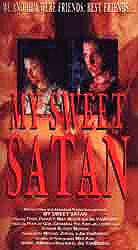 Posted : 17 years ago on 12 June 2008 04:40
(A review of My Sweet Satan (1994))
Posted : 17 years ago on 12 June 2008 04:40
(A review of My Sweet Satan (1994))MY SWEET SATAN is an excellent 20 minute short film made in 1993 by Ohio-based independent filmmaker Jim Van Bebber. Van Bebber made his feature film debut in 1988 with the gritty urban action/exploitation movie DEADBEAT AT DAWN. My Sweet Satan is based on the true story of Ricky Kasso, also known as "The Acid King", who was a member of a satanic cult of metalheads known as the "Knights of the Black Circle". They apparently held one of their rituals on the site of the actual Amityville Horror house. In 1984 Kasso and one of his friends were arrested for the prolonged torture and murder of Gary Lauwers, who had stolen 10 bags of angel dust from Kasso while he was passed out at a party. Two days after his arrest Kasso commited suicide by hanging himself in his cell. In MY SWEET SATAN Van Bebber stars as Ricky Kasslin (I assume the name was modified due to legal issues); and like his anti-hero character Goose in DEADBEAT AT DAWN Van Bebber really has a commanding and charismatic screen presence. The film starts off with Kasslin hanging himself in his prison cell, then the story flashes back to the days leading up to his imprisonment. I like the scene near the beginning where an American flag mural on a wall fills the screen as Kasslin walks up and into frame like General Patton about to address his troops. Except Kasslin's "troops" are a group of outcast teens who hang out with him because he has great drugs and they have nothing else better to do. Kasslin and his pals spend their days out in the woods sacrificing animals to Satan, headbanging to metal, drinking, and smoking weed (while proclaiming, "We smoke this marijuana in your name Satan"). At a party one night Gary (Mike Moore) steals $96 out of Kasslin's pocket when he thought Kasslin was passed out. As a result, Kasslin and his best friend Jimmy (Terek Puckett) set Garry up by offering him free hits of acid and taking him into the woods where they brutally murder him as a sacrifice to Satan. Then the film leaps back to Kasslin hanging himself in his cell. I usually don't give away the conclusion of a film in my reviews, but this is a short film which is not about a twist ending or anything like that. You can tell where the film's headed right from the start; and it's told in a semi-documentary fashion where Kasslin's friends are narrating the events after-the-fact. This style of semi-documentary storytelling would be put to effective use in Van Bebber's excellent second feature film THE MANSON FAMILY (which I highly recommend). The Director of Photography on MY SWEET SATAN was Mike King who was also the DP on DEADBEAT AT DAWN. Both films were shot on 16mm, but where as DEADBEAT AT DAWN had a dirty gritty print due to the fact that they were going for a '70s grindhouse/exploitation look, MY SWEET SATAN has a clear clean print (which suits the straightforward semi-documentary aspect of the film). As far as the shock-factor, there's an actual (male) nipple piercing performed at one of the parties. Whether this is shocking to you or not depends on whether you find body piercing shocking. I have piercings and I've seen enough that it doesn't shock me in real life; but there's something about seeing it on film in extreme close-up that's still cringe-worthy. And the murder of Gary is brutal, disturbing, and gory all at the same time (so splatter fans take note). The chilling aspect of the murder will linger with you long after the film's over.
 0 comments, Reply to this entry
0 comments, Reply to this entry
Deadbeat at Dawn Review
 Posted : 17 years ago on 7 June 2008 12:27
(A review of Deadbeat at Dawn)
Posted : 17 years ago on 7 June 2008 12:27
(A review of Deadbeat at Dawn)DEADBEAT AT DAWN is gritty ultra-low budget filmmaking at its finest; and it should be recognized along side other influential '80s exploitation classics like EVIL DEAD, BASKET CASE, and RE-ANIMATOR because it's just as important. It was released in 1988 and written, directed by and starring Dayton, Ohio's Jim Van Bebber. DEADBEAT AT DAWN melds together action, martial arts, crime drama, horror, graphic violence and splatter into a hugely entertaining tribute to '70s drive-in cinema. The story concerns Goose (Jim Van Bebber) as the leader of a street gang called The Ravens. He decides to quit the gang and make one last drug deal before settling down with his girlfriend Christy (Megan Murphy). Danny Carmodie (Paul Harper), leader of a rival gang called The Spiders, considers Goose "fair game" now that he's quit The Ravens. He sends two of his minions, Bone Crusher (Marc Pitman) and Stubby to kill him. While Goose is out making his drug deal, Bone Crusher and Stubby force their way into his ramshackle apartment and brutally beat his girlfriend to death. Goose comes home, discovers her bloody body and is of course grief stricken. He's not grief-stricken enough to report it however; instead he disposes of her body in the buildings trash-compactor?! He hides out with his Vietnam veteran, heroin addicted father for a while. There are a few grimy and depressing scenes with his paranoid, strung-out father before grief and despair finally get the best of him, and he decides suicide may be the answer. Before he can blow his brains out, Keith (Ric Walker) the new leader of The Ravens finds him, sobers him up, and brings him in on an armored car robbery that The Ravens and The Spiders are planning together. Goose goes along with it just long enough to exact bloody revenge on Danny and the rest of The Spiders. That's basically what the movie boils down to - a revenge thriller filled with some excellent '80s splatter effects - knife wounds, slow motion blood sqibs, decapitation, and a spectacular throat-ripping (done just as effectively as any Lucio Fulci throat-ripping). The gritty look of the film comes from the fact that it was shot on 16mm reversal film stock; and as such, it achieves that pseudo-documentary look of films like TEXAS CHAINSAW MASSACRE, DERANGED, MANIAC, and COMBAT SHOCK. The grittiness is also helped out by the film being shot in some of the seediest-looking locations in Dayton, Ohio. While most of the movie is lit with natural light or white light, there are some scenes lit with bright reds, yellows and greens that add a certain nuance to those scenes; and at certain points in the film there are these '60s style psychedelic kaleidoscope transitions between scenes that compliment the lighting scheme I just mentioned. All this adds to the richness and texture of the film in my opinion, and gives it that '60s and '70s drive-in movie look that Van Bebber was going for. The acting is as to be expected from an ultr-low budget film, but there are some stand-out performances. Jim Van Bebber as Goose has a great screen presence and is the quintessential anti-hero. Paul Harper as Danny (leader of The Spiders gang) handles his role well. But my favorite performance is by Marc Pitman as Bone Crusher (one twisted and sadistic mofo), especially the scene before they kill Goose's girlfriend. He's ranting and raving about about his nihilistic philosophy on life, and it includes such choice lines as, "Man that ain't nuthin' compared to the rush you can get when you're killin' somebody, man. When you're lookin' in their eyes and you're seein' all that life go right out of 'em. It's power." , "I hate people, man! I don't care. I don't give a sh*t. I don't give a sh*t about nuthin'. Man, all my life people have f*cked with me! I just f*ckin' hate people. And I don't care!....Awww! I'm the baddest mutherf*cker you ever seen, man!". Jim Van Bebber's name should be synonymous with Stuart Gordon, Frank Henenlotter and Sam Raimi; and it would be except that his output has unfortunately been minimal. After DEADBEAT AT DAWN (his first feature film) he made the short serial killer/cannibal film ROADKILL: THE LAST DAYS OF JOHN MARTIN in 1988, and another excellent short film called MY SWEET SATAN (based on real life killer Ricky Kasso) in 1993. He made another short film in 1994 called DOPER. He began his second feature film, CHARLIE'S FAMILY, in 1995, but due to lack of funding it remained unfinished until DVD distributor Blue Underground helped fund its completion in 2003; and it was finally released under the title THE MANSON FAMILY. Van Bebber has also directed music videos for the following artists: Skinny Puppy, Necrophagia, Pantera, and Superjoint Ritual. I would personally love to see him make the film CHUNK BLOWER, which he shot a 4 minute promo for back in 1990. It looks like a great film for slasher/splatter fans. Someone needs to give Van Bebber some funding. The man has talent.
 0 comments, Reply to this entry
0 comments, Reply to this entry
The Black Cat Review
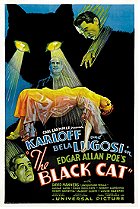 Posted : 17 years, 1 month ago on 5 June 2008 03:04
(A review of The Black Cat)
Posted : 17 years, 1 month ago on 5 June 2008 03:04
(A review of The Black Cat)Those looking for an accurate adaptation of Edgar Allan Poe's short story should look elsewhere. About the only thing this film has in common with Poe's story is the fact that there is a black cat in the movie, and Lugosi's character is deathly afraid of black cats. If on the other hand you're looking for some great moments in classic horror, then you should definitely check out THE BLACK CAT. It stars both Boris Karloff and Bela Lugosi. I've seen a few films starring both horror legends together (THE RAVEN, THE INVISIBLE RAY, SON OF FRANKENSTEIN, and BLACK FRIDAY); but in my opinion THE BLACK CAT features the best performances of both actors together. They play so well off of each other in this film. The story concerns a young couple Peter (played by David Manners) and Joan (played by Jacqueline Wells) who are honeymooning in Hungary and traveling by way of the Orient Express. They share a train compartment with Dr. Vitus Werdegast (Bela Lugosi) is going back to his homeland to visit an "old friend", Hjalmar Poelzig (Boris Karloff). Dr Vitus relates a story to them of how he left his wife and daughter 18 years ago to go to war, and how he was captured and imprisoned for the last 15 years. Once they reach the train station, the three board a bus. In route to a hotel, the bus crashes and Joan is injured. Dr. Vitus decides to take them to Poelzig's estate which is within walking distance. The estate is a sprawling post-modern, futuristic (for the '30s anyway) fortress; which is later revealed to have been built by Poelzig on the ruins of the fort where Dr. Vitus was captured. It's an interesting setting and quite a departure from Universal's classic horror movies of the time, which were usually set in a gothic, cobweb-filled castle or mansion. There are some wonderful expressionist scenes throughout the movie using this "futuristic" house setting. It is revealed that Poelzig's (Karloff) traitorous actions were responsible for Dr. Vitus' (Lugosi) capture and imprisonment. After Vitus was imprisoned, Poelzig convinced Vitus' wife that he had died. Two years later she died of pneumonia (and Poelzig keeps her perfectly-preserved body in a concealed room in the house). Poelzig has married Vitus' daughter Karen (played by Lucille Lund), who he also keeps hidden in the house. Dr. Vitus has returned for revenge. Poelzig also happens to be a satanic high priest and is planning on sacrificing Joan in a ritual. Karloff as Poelzig is certainly sinister and is meant to be the "bad guy" of the movie. I really like the ambiguity of Lugosi's Dr. Vitus character. He seems almost as sinister as Karloff in some scenes, and you're not even sure if he's a "good guy" until near the end of the movie (and even then he manages to indulge in a little sadism in the conclusion).
 0 comments, Reply to this entry
0 comments, Reply to this entry
 Login
Login
 Home
Home 64 Lists
64 Lists 52 Reviews
52 Reviews Collections
Collections